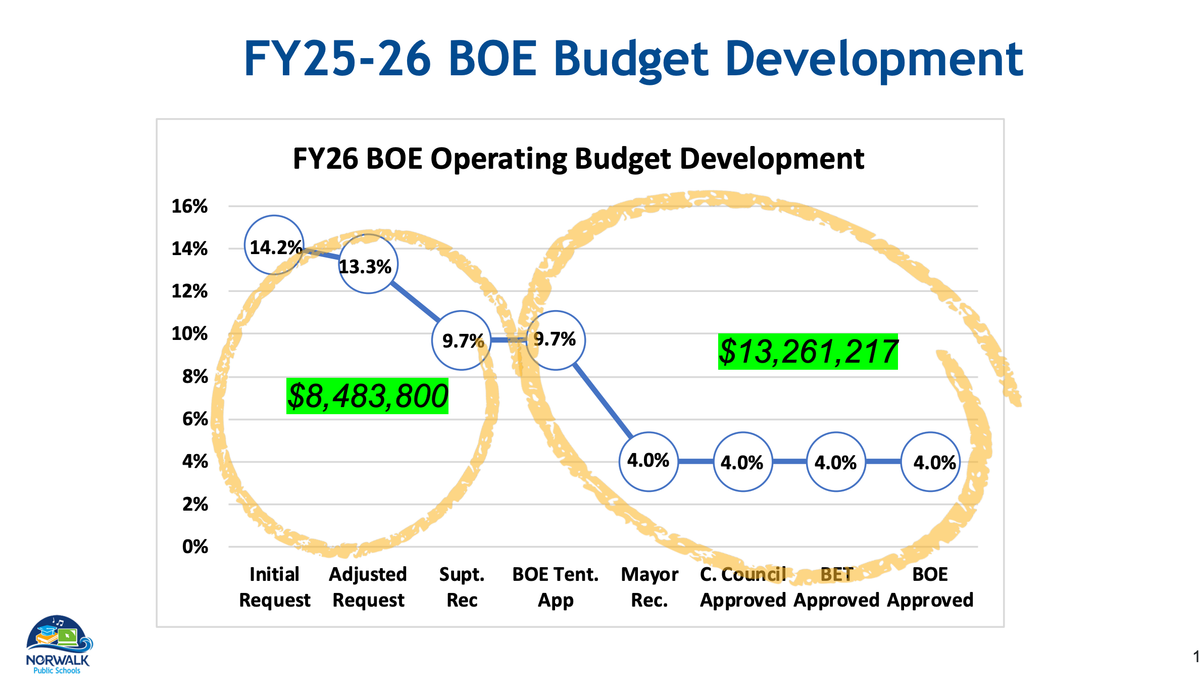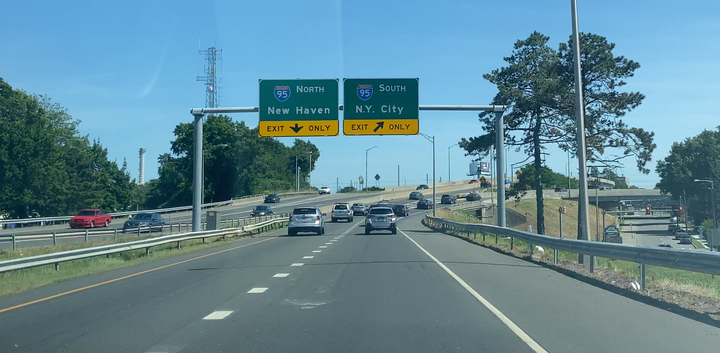Hundreds of Teachers, School Programs Face Elimination as Southwest Connecticut Schools Grapple with Funding Challenges
Districts across SW CT, especially Norwalk and Bridgeport, are facing difficult decisions as they aim to balance their school budgets.

Cuts to teachers, music programs, support staff, counselors, and more are taking place across southwest Connecticut as school districts deal with budget challenges. The lives of thousands of students will soon be impacted as many lose supportive resources, popular programs, and maybe even a favorite teacher.
Some districts faced smaller budget challenges. In Stamford, for example, the Board of Finance cut its budget request by $3.5 million, forcing the school district to eliminate six special education teachers and two high school counselors.
But for Norwalk and Bridgeport, the scale of the cuts are massive. Norwalk’s Board of Education is weighing a plan that would cut more than 100 teaching positions, eliminate music and band at the elementary school level, and more. Bridgeport’s Board of Education, facing an approximately $30 million budget gap, supported a plan that would eliminate assistant principals and programming, cut kindergarten paraprofessionals and library media specialists, provide less bus service to students, and more.
“These cuts represent actual human beings,” Jeff Morrissey, president of the Bridgeport Education Association, told the board in April. “The numbers on your spreadsheets represent adults who wake up every morning and choose to dedicate their days to the children of Bridgeport. They represent children who will lose instruction in art and music. They represent children whose learning needs won't be met by trained interventionalists. And represent children who will lose opportunities to research and learn a love of literacy when they haven't the opportunity to communicate or connect with a librarian or media specialist.”
Parents and students in these districts said these types of cuts were “a travesty” to their education.
“The loss of even one frontline person, one educator is a travesty, because that one person is not going to be here to make a difference in the life of a child who really, really needs it,” Norwalk parent Donna Spellman said. “The kids don’t know nor do they don’t care who’s in central office, but I promise you they know who’s in their classroom. They know who’s in their school.”
The question many community members are asking is why. Why are districts across the region facing these funding challenges, particularly as all districts saw an increase in their budgets from the previous year?
A Perfect Storm
For many districts this year is a perfect storm—increased expenses, coupled with a decrease in federal support. Since 2020, school districts have benefited from three rounds of ESSER (Elementary and Secondary School Emergency Relief Fund) federal funds that aimed to help schools and students recover from the pandemic. The seven districts in southwest Connecticut alone received hundreds of millions that went to enhancing school infrastructure, providing additional resources, like counselors and tutors, and adding programming to help address educational losses caused by the pandemic.
Now that money has been spent. And the funds, from the start, were intended to be one-time only investments, not recurring funds—something districts and cities were told when they first received themBut the loss left districts with a choice, scale back those programs or add those costs to the operating budget.
Norwalk is facing one of the biggest challenges in our region due in large part to the fact that they moved funds supporting enhanced programs and many salaries of support staff into the grants budget—which is now gone.
Some school and city officials sounded the alarm in the past few years, saying the district would face a “fiscal cliff,” once the federal funds dried up, but neither the city nor the school district took proactive measures. The Board of Estimate and Taxation, which is the city’s financial body, voted to flat fund the school district during the 2020-21 school year, but has since provided increases of about 3 to 4% each year. At the same time, the Board of Education has continued to ask for increases of more than 8% or 9% and then used these temporary funds to plug the gap.
This year, the cliff officially is here. The school district asked for a 9.7% increase, or about $22 million. The city provided a 4% increase, leaving the Board of Education to trim its budget by $13 million.
“The scale and magnitude of the reduction from the initial request to the 4% is significant and with that challenge, it’s very difficult, almost impossible to not impact students,” Lunda Asmani, the chief financial officer for Norwalk Public Schools told the Board of Education’s Finance Committee in May.
Asmani and Superintendent Alexandra Estrella’s proposal for reducing the gap include cutting more than 100 positions across the district, including paraprofessionals; band, dance, and strings teachers in the elementary schools, classroom teachers, some central office staff, and more.
Difficult Decisions Amid Loss of Funds
In Bridgeport, the board approved a budget last year with a $26 million gap, and had planned to use $26 million from its reserve fund. That exacerbated issues this year, with the district staring down a $38 million budget gap, according to school officials.
"Our priority is to ensure that our students continue to receive a high-quality education while we work diligently to resolve these financial issues,” said Dr. Royce Avery, acting superintendent in a November statement when the gap was first brought up.“While we foresee several cuts to the budget during the 2024-25 school year, we intend to make as few changes to academics as possible, which includes staffing and programs.”
Avery was handed this challenge in November after the previous superintendent Carmela Levy-David took a leave of absence after 93% of district teachers in a survey said they found her “unprofessional and not open to differing points of view,” according to CT Mirror.
The district began making cuts throughout the year, but still faced an approximately $30 million budget gap in April. That’s when the board adopted the superintendent’s reductions to help them get to a balanced budget. Those included eliminating kindergarten paraprofessionals, increasing the distance from school students had to live in order to get a bus, eliminating 18 assistant principals and 8-9 central office staff, cutting the performing, visual arts, theatre, and drama program, eliminating media/library specialists, and more.
“We've slashed everything,” Avery told the Finance Committee of the Board of Education on June 4. “We're at rock bottom in what we're providing our children across the district … to get to this point, to get a balanced budget.”
Increased Expenses
At the same time, districts are also facing a crunch as their expenses continue to rise. In addition to standard contractual increases, such as teachers’ salaries or health care costs, districts are seeing increases in transportation costs, food service expenses, and more.
The biggest challenge, however, is that most districts in our region are seeing a growth in high-needs students—classified as students that have a disability, those who are low-income, and/or those who are English language learners. All of these types of students require more resources and supports, which cost more money.
In Bridgeport, for example, in 2019-20—the school year that started before the pandemic hit—82.5% of its student body was classified as high-need, according to data from EdSight, the state’s school data portal. For 2024-25 that number was 92.6%. The overall number of students stayed relatively consistent, with 20,311 in 2019-20 and 20,002 in 2024-25. The district has seen its English language learner population steadily grow, from 20.3% in 2019-20 to more than 31% in 2024-25.
Stamford has also seen its high need population tick up, from 65.6% of the student body in 2019-20 to 67% in 2024-25, as its English language learner population has grown from 14.4% to 19.3% and its special education population has grown 14.5% to 17.5% during the same time.
In Norwalk, the percentage of high-needs students has stayed relatively consistent, at 67.7% in 2019-20 to 67.1% in 2024-25, but its English language learner population has grown from 17.4% to 23.4% over that same time. In addition, its special education population has grown from 14.7% of the student body to 18.6%.
This also shows the gaps that exist among districts in our region. Greenwich, for example, with 33% of its students classified as high-need, spends the most per pupil in the region at just under $28,000, according to data from EdSight. Other districts spend much less. Bridgeport spends the least at $18,922 per student, while Stamford spends $23,201 and Norwalk spends $22,245.
However, based on the state’s educational cost sharing formula, those districts get a wide range of state funding. In 2024-25, Bridgeport received $192.5 million in ECS funding, while Norwalk received just $14.3 million, and Stamford received $17 million.
Still, Bridgeport officials highlighted some of the unique challenges of their district—and others like Norwalk and Stamford—and said they should receive additional state funding.
“They seem to be willing to spend a few $100 million to take care of problems that affect wealthier communities that are in a better position to deal with their problems—that's what I find shameful, the compromises that came out of the governor's office and now the legislature are paying for problems that affect wealthier communities,” BOE member Robert Traber said at the Board of Education meeting in April.
Traber specifically cited the plans to support special education and expand child care programs in the state.
“They're not dealing with the impact of poverty on education,” he said. “They're not dealing with the 13-year failure to raise the base rate in the educational cost sharing formula [or how the state provides aid to schools.] They're not dealing with the dramatic increase in multi-language learners in our community, in our districts, they're not dealing with any of that, which is dramatically increasing the cost of education in our districts. They're only dealing with the problems that affect everybody.”
Possible State Help
Still, there is potentially some relief heading to some districts now that the state’s budget has been adopted. Bridgeport school board members expressed hope that they would be able to bring back some of the reduced positions with some additional state funding. The board is meeting on Monday, June 9 to learn more about what was included in the budget for the city.
Check back for part 2 next week, following the Norwalk and Bridgeport Board of Education meetings.



